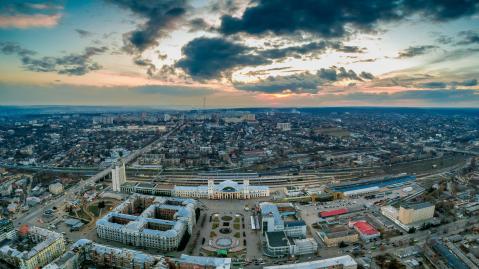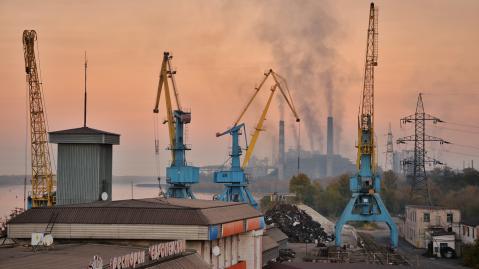COP29: Keeping Climate Security Human-Centric
toda.org, 19th November 2024
News publ. 03. Feb 2023

Russia’s aggression has damaged or completely destroyed large parts of Ukraine. Rebuilding the country will take many years and is by no means an easy task. In a new publication, adelphi proposes several principles for the green reconstruction of Ukraine.
Cities in Ukraine like Mariupol and Kharkiv will need to be rebuilt extensively. Some smaller cities need to be put back together again from scratch. Hundreds of thousands of Ukrainians need new homes. Roads, bridges, train stations, airports… Ukrainian infrastructure has been repeatedly targeted by Russian missiles. Damage to the country’s agricultural sector thus far amounts to approximately six billion euros. Most state-owned mines in the coal regions have become unprofitable, occupied, or destroyed entirely. Meanwhile, the Ukrainian people are resolute in their defence of their country and continue to fight for survival.
A crucial question arises: In view of the ongoing war and the immense human, economic, and ecological loss, is it premature or even presumptuous to think seriously about the reconstruction of Ukraine’s destroyed infrastructure? And that this should then also be “green”? In fact, these questions are redundant: because reconstruction has long been underway, for example in regions that have already been liberated from Russia, such as Kiev and Chernihiv. Indeed, this is not only a matter of rapid reconstruction and the restoration of basic state services, but also of Ukraine’s future economic development.

Before the war: Kharkiv, Ukraine
The Ukrainian government and its international partners have already emphasised the need for and importance of Ukraine’s green recovery. In summer 2022, Ukraine presented its Recovery Plan at an international conference in Lugano. Transparency and sustainability were among the guiding principles agreed at the conference for Ukraine’s reconstruction. A green reconstruction would enable Ukraine to achieve its key social, economic, and geopolitical goals: to become energy independent from Russian fossil fuels, to accelerate integration with the EU, and to reap the social and environmental benefits of such a green recovery. It would also provide the opportunity to unlock new economic opportunities and avoid stranded assets.
However, a green reconstruction will not be easy, due to numerous compromises that would need to be struck and the need to override strong historical dependencies. A green reconstruction will require thorough planning and implementation. Despite these challenges, a consensus is emerging that the reconstruction of Ukraine must pave the way for sustainable, low-carbon development that is in line with the 2030 Agenda for Sustainable Development and the United Nations’ Paris Agreement on climate. As Ukraine seeks to join the EU, it is critical that its reconstruction also aligns with the goals and principles of the European Green Deal, write authors of the study, Iryna Holovko and adelphi Managing Director Constanze Haug. This includes the ambitious goal of becoming climate neutral by 2050.

The adelphi experts suggest that the reconstruction process should be inclusive and transparent and involve Ukrainian decision-makers, businesses, regional and local authorities in the affected regions, and civil society organisations. The needs of the public must also be taken into account to ensure high levels of support. To make its reconstruction efficient and effective, and to give international partners and donors the assurance that financial resources are being used wisely, Ukraine must ensure transparency in spending and push ahead with reforms to combat corruption and uphold the rule of law – for this, good governance will be key.
A ministry or agency could serve as a central coordinating body for international partners and Ukrainian authorities. More support should be channelled towards technology, research, education, and innovation, in order to secure local understanding of the implementation of low-carbon technologies and high standards of energy efficiency. Green finance, for which there are many different avenues, should be made available for climate-friendly projects. Climate change should be taken into account in all reconstruction investments to avoid carbon lock-in as much as possible.

A vision for Ukraine’s post-war green reconstruction must be set out in all key sectors of the economy. In cities and urban areas, energy efficiency in houses – both those newly built, and those being renovated – and resilience to climate impacts should be increased. The expansion of public transport under the banner of smart mobility should be made a priority. Local solutions for electricity and heating in combination with renewables can modernise energy infrastructure. Much needs to be repaired or replaced here anyway, including damaged thermal power plants and boilers, parts of the high-voltage and distribution networks, and numerous renewable energy plants, especially solar. Though their initial destruction is harsh, cities needing to be rebuilt are an opportunity to improve green urban planning with a focus on climate adaptation, also in cooperation with other European cities or within the framework of EU initiatives such as the New European Bauhaus.
It is equally important for heavy industry and manufacturing to bypass the emissions-intensive technologies from the 20th century. Instead, Ukraine should be increasingly integrated into new value chains and markets for low-carbon products. Conventional steel and iron production, for example, is unlikely to be profitable in the next five to ten years regardless. In the transport sector, the reconstruction and expansion of rail infrastructure should be made a top priority, as rail is still the most energy-efficient and sustainable form of transport.
The restoration of Ukraine’s agricultural sector should go hand in hand with support for the affected rural regions. Hundreds of villages across the country have been and continue to be devastated by the war. In particular, the paper suggests prioritising support for small and medium-sized farms, where 80 percent of all agricultural workers are employed. Financial support should be linked to programmes for knowledge exchange on sustainable agriculture and adaptation to EU rules and regulations. Investments in rehabilitating state-owned mines in coal-mining regions are unlikely to pay off and would result in stranded assets. The socially just transformation of coal regions has already begun and should be further supported so they can make way for new long-term development prospects for previously disadvantaged areas.

The new study recommends that Ukraine’s partners, including the EU, its members and organisations, the USA, and the G7, take several steps. They should work with the Ukrainian government to align its reconstruction plan with the goals of the European Green Deal and identify priorities and targets. They should agree on structural reforms and implementation deadlines related to anti-corruption and rule of law, both essential for a green and transparent recovery. To operationalise this, a set of indicators similar to the EU taxonomy would give all stakeholders clear guidance on sustainable investments.
With the publication “Rebuilding Ukraine: Principles for a green post-war reconstruction” adelphi hopes to contribute to the planning of Ukraine’s reconstruction. Download the paper here for free.
Contact: holovko adelphi [dot] de (Iryna Holovko), Advisor at adelphi
adelphi [dot] de (Iryna Holovko), Advisor at adelphi